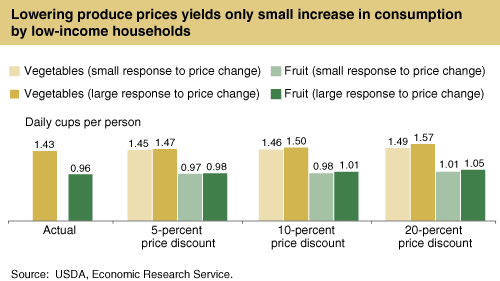Price Reductions Have Little Effect on Fruit and Vegetable Consumption by Low-Income Americans
- by Diansheng Dong and Biing-Hwan Lin
- 9/1/2009
Like other U.S. households, low-income households tend to consume below the recommended amounts of fruit and vegetables. USDA recently implemented several strategies to improve food choices by low-income households, including nutrition education and vouchers for purchasing fresh fruit and vegetables. Some policymakers also are interested in using economic incentives, such as price discounts on fruit and vegetables, to encourage low-income households to eat more nutritious food.
The success of a price-discount program will depend on how much consumers increase purchases in response to lower fruit and vegetable prices, a measure referred to as price elasticity. A 2009 ERS study indicates that reduced prices will not significantly boost fruit and vegetable demand by low-income Americans. Previous research shows that fruit and vegetable demand is not sensitive to price changes; that is, the percentage increase in consumption is lower than the percentage decrease in price. For the same reason, ERS researchers have found that taxing unhealthy snacks would have limited effects on curtailing consumption.
The ERS study examined the effect of three retail price discounts (5, 10, and 20 percent) to predict how low-income consumers might increase their purchases of fruit and vegetables. Using a range of price elasticities and estimates of food consumption by low-income Americans, ERS calculated that with a 10-percent price discount at the retail level, low-income households would increase their consumption of fruit by 2.1 to 5.2 percent (from 0.96 cup to 0.98-1.01 cups per person per day) and vegetables by 2.1 to 4.9 percent (from 1.43 cups to 1.46-1.50 cups). These higher quantities are still below the 2 cups of fruit and 2.5 cups of vegetables per day recommended in the 2005 Dietary Guidelines for Americans.
Program costs are an important consideration when contemplating a policy intervention. Subsidizing low-income households’ fruit and vegetable purchases by 10 percent would cost the Government $303-$312 million, depending on the price-sensitivity of demand, per year for fruit and $268-$279 million for vegetables. The cost of subsidizing produce purchases would equal about 7 to 8 percent of the $7.6 billion low-income households spend annually on fruit and vegetables.
This article is drawn from:
- Dong, D. & Lin, B. (2009). Fruit and Vegetable Consumption by Low-Income Americans: Would a Price Reduction Make a Difference?. U.S. Department of Agriculture, Economic Research Service. ERR-70.
You may also like:
- Diet Quality & Nutrition. (n.d.). U.S. Department of Agriculture, Economic Research Service.
- Stewart, H. & Blisard, N. (2008). Are Lower Income Households Willing and Able To Budget for Fruits and Vegetables?. U.S. Department of Agriculture, Economic Research Service. ERR-54.


